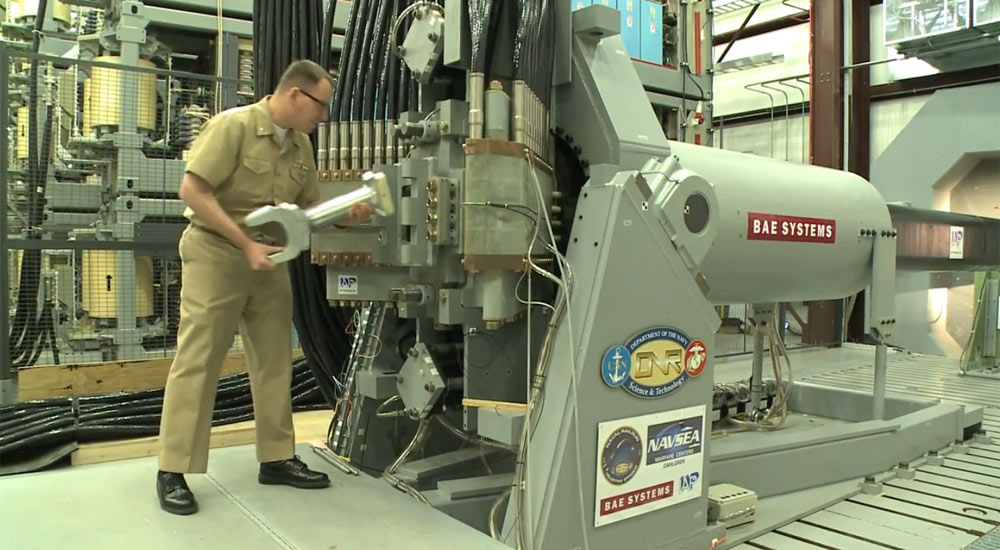New Navy Railgun Tests Leading to Ship Superweapon by 2020

The first weapon-scale prototype of a futuristic Navy railgun began undergoing firing tests last week, the next big step toward putting the electromagnetic superweapon on U.S. warships by 2020. The Navy envisions using railguns to destroy enemy ships, defend against enemy missiles, or bombard land targets in support of Marines hitting the beaches.
Newly released video shows the prototype railgun using an electric-powered launcher rather than gunpowder to fire a huge hypersonic bullet in a cloud of flame and smoke. The Office of Naval Research hopes its new test phase — scheduled to last until 2017 — leads to a Navy weapon capable of hurling 40-pound projectiles at speeds of 4,500 mph to 5,600 mph over 50 to 100 miles (7,240 to 9,010 kilometers per hour over 80 to 161 kilometers).
The full-size prototype, made by BAE Systems, "looks like a real gun," said Roger Ellis, program manager for the railgun at the Office of Naval Research, during a media teleconference today (Feb. 28). Previous tests involved clunky laboratory prototypes that would never see action aboard a Navy warship.
U.S. Navy commanders ultimately want a weapon capable of firing up to 10 guided projectiles per minute at targets up to 100 miles away. Navy warships currently have 5-inch guns capable of firing at distances of 13 miles.
"There is potential to replace the 5-inch gun, but it would do far more," Ellis said in response to an InnovationNewsDaily question. The railgun could hit the same distant targets that Navy missiles strike today, he said.
The flames that appear in the video of the test firing come from a combination of electricity arcing across the launcher, shavings of aluminum reacting with the air, and the bullet's hypersonic flight, said Tom Boucher, test director for the railgun at the Naval Surface Warfare Center Dahlgren Division in Virginia.
A second railgun prototype, built by General Atomics, is set to arrive for testing in April, Ellis said. Having railguns built by different companies gives the Navy a choice if it ultimately decides to deploy the superweapon.
Get the world’s most fascinating discoveries delivered straight to your inbox.
Both General Atomics and BAE Systems committed millions of their own dollars during the first $240 million test phase, which recently ended. The newly begun Phase II is funded at about the same amount. It is testing prototypes capable of harnessing 32 megajoules of energy. Just one megajoule would be enough to throw a 1-ton car 100 mph.
During the five years of Phase II, the Navy plans to test cooling systems and a battery that could store the energy required by the railgun. It has contracted with General Atomics, BAE Systems and Raytheon for designs for a pulsed power system.
Because of its hypersonic speed produced by the railgun, a projectile shaped like a bullet could deliver devastating damage even without exploding. It could include electronic guidance systems such as GPS that would be protected against the immense heat of the giant bullet's hypersonic passage.
"The rounds we are firing currently are non-aerodynamic slugs," Ellis said of the testing. "They match the interior ballistics of what the launcher is expected to see but are intended to slow down quickly."
If all goes well, the Navy could end up equipping its ships with railguns of all different sizes. Companies such as General Atomics have already built smaller railguns for their own testing purposes.
"We believe this is game-changing technology, and in our case we've invested internal funds of more than $20 million for a subscale prototype to move the technology forward," said Tom Hurn, director of railgun programs at San Diego-based General Atomics.
This story was provided by InnovationNewsDaily, a sister site to Live Science. You can follow InnovationNewsDaily Senior Writer Jeremy Hsu on Twitter @ScienceHsu. Follow InnovationNewsDaily on Twitter @News_Innovation, or on Facebook.





